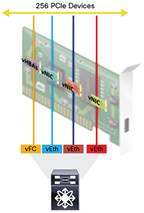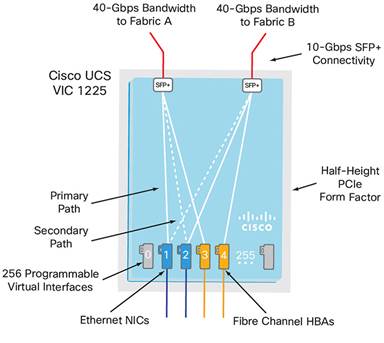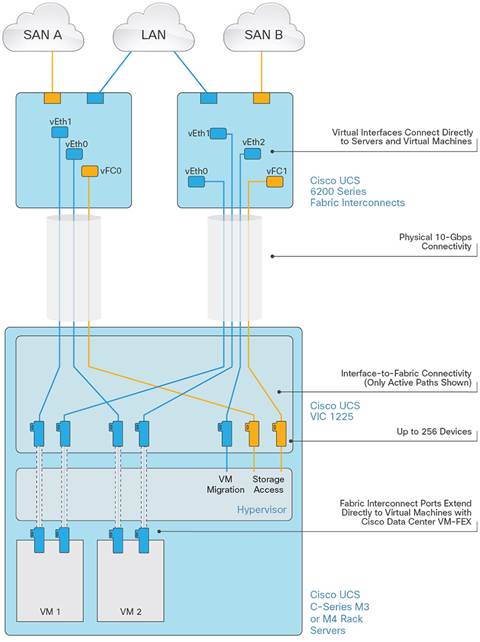Cisco UCS Virtual Interface Card 1285 Data Sheet
Available Languages
Cisco Unified Computing System Overview
The Cisco Unified Computing System™ (Cisco UCS®) is a next-generation data center platform that unites computing, networking, storage access, and virtualization resources in a cohesive system designed to reduce total cost of ownership (TCO) and increase business agility. The system integrates a low-latency, lossless 10 or 40 Gigabit Ethernet unified network fabric with enterprise-class blade and rack x86-architecture servers. The system is an integrated, scalable, multichassis platform in which all resources participate in a unified management domain.
Product Overview
A Cisco® innovation, the Cisco UCS Virtual Interface Card (VIC) 1285 is a dual-port Enhanced Quad Small Form-Factor Pluggable (QSFP) 40 Gigabit Ethernet and Fibre Channel over Ethernet (FCoE)-capable half-height PCI Express (PCIe) card designed exclusively for Cisco UCS C-Series Rack Servers. It incorporates Cisco’s next-generation converged network adapter (CNA) technology, with a comprehensive feature set, providing investment protection for future feature software releases. The card enables a policy-based, stateless, agile server infrastructure that can present up to 256 PCIe standards-compliant interfaces to the host that can be dynamically configured as either network interface cards (NICs) or host bus adapters (HBAs). In addition, the Cisco UCS VIC 1285 supports Cisco Data Center Virtual Machine Fabric Extender (VM-FEX) technology, which extends the Cisco UCS fabric interconnect ports to virtual machines, simplifying server virtualization deployment.
Features and Benefits
The Cisco UCS VIC 1285 provides the following features and benefits:
● Stateless and agile platform: The personality of the card is determined dynamically at boot time using the service profile associated with the server. The number, type (NIC or HBA), identity (MAC address and World Wide Name [WWN]), failover policy, bandwidth, and quality-of-service (QoS) policies of the PCIe interfaces are all determined using the service profile. The capability to define, create, and use interfaces on demand provides a stateless and agile server infrastructure (Figure 1).

● Network interface virtualization: Each PCIe interface created on the VIC is associated with an interface on the Cisco UCS fabric interconnect, providing complete network separation for each virtual cable between a PCIe device on the VIC and the interface on the fabric interconnect (Figure 3).

Advanced Features
The Cisco UCS VIC 1285 provides high network performance and low latency for the most demanding applications:
● Big data, high-performance computing (HPC), and high-performance trading (HPT)
● Large-scale virtual machine deployments
● High-bandwidth storage targets and archives
When the Cisco UCS VIC 1285 is used in combination with Cisco Nexus® 3000 Series Switches, big data and financial trading applications benefit from high bandwidth and latency of approximately 1 microsecond. When the VIC is connected to Cisco Nexus 5000 Series Switches, pools of virtual hosts scale with greater speed and agility using four 10-Gbps PortChannel connections. The Cisco Nexus 6004 Switch provides native 40-Gbps FCoE connectivity from the Cisco UCS VIC 1285 to both Ethernet and Fibre Channel targets.
The Cisco UCS VIC provides industry-leading performance and features:
● Cisco NetFlow: Cisco NetFlow is supported at the adapter level providing network traffic accounting and monitoring down to the virtual machine level for network billing, security, traffic characterization, and denial-of-service (DoS) attack monitoring. Cisco NetFlow provides valuable information about network users and applications, peak use times, and traffic routing.
● User-space NIC (USNIC): USNIC is an ultra-low-latency solution for HPC and HPT applications over Ethernet. The solution includes firmware, kernel driver, user-space driver, and Open Message Passing Interface (MPI) support for Cisco VICs and provides OS bypass services directly to the application layer.
● Cisco Data Center VM-FEX: Cisco Data Center VM-FEX technology extends fabric interconnect ports directly to virtual machines, eliminating software-based switching in the hypervisor. Cisco Data Center VM-FEX collapses virtual and physical networking infrastructure into a single infrastructure that is fully aware of the virtual machines’ locations and networking policies (Figure 3). Cisco Data Center VM-FEX is implemented by Cisco VICs with a prestandard implementation of IEEE 802.1BR Port Extender.

Table 1 summarizes the main features and benefits of the Cisco UCS VIC 1285.
Table 1. Features and Benefits
| Feature |
Benefit |
| x16 PCIe generation-2 interfaces |
Delivers greater throughput |
| 2 x 40-Gbps unified I/O |
● Delivers 80 Gbps to the server
● Delivers over 100 Gbps In a dual VIC configuration with the Cisco UCS C240 M3 Rack Server
● Helps reduce TCO by consolidating the overall number of NICs, HBAs, cables, and switches because LAN and SAN traffic run over the same adapter card and fabric
|
| Up to 256 dynamic virtual adapters and interfaces |
● Creates fully functional unique and independent PCIe adapters and interfaces (NICs or HBAs) without requiring single-root I/O virtualization (SR-IOV) support from OSs or hypervisors
● Allows these virtual interfaces and adapters to be configured and operated independently, just like physical interfaces and adapters
● Creates a highly flexible I/O environment needing only one card for all I/O configurations
Note: Cisco UCS VIC 1285 hardware is SR-IOV capable, and you can enable SR-IOV after SR-IOV is broadly supported by the popular operating systems. Please refer to Cisco UCS Manager configuration limits for your specific OS and environment in the configuration guide. |
| Low-latency connectivity |
Supports USNIC technology, delivering latency as low as 1.2 microseconds in back-to-back VIC connections; standard latency using the Cisco Nexus 3000 Series Switch is approximately 2 microseconds |
| Cisco Data Center VM-FEX technology |
● Unifies virtual and physical networking in a single infrastructure
● Provides virtual machine visibility from the physical network and a consistent network operating model for physical and virtual servers
● Enables configurations and policies to follow the virtual machine during virtual machine migration
● Provides a prestandard implementation of the IEEE 802.1BR Port Extender standard
|
| Fibre Channel |
Supports FCoE Fibre Channel with 10-15 bit error rate (BER) connected to the Cisco Nexus 6004 Switch |
| Network architecture |
Provides a redundant path to the fabric interconnect using hardware-based fabric failover |
| More than 600,000 I/O operations per second (IOPS) |
Provides high I/O performance for demanding applications |
| Support for lossless Ethernet |
Uses Priority Flow Control (PFC) to enable FCoE as part of the Cisco unified fabric |
| Broad OS and hypervisor support |
Supports customer requirements for Microsoft Windows, Red Hat Enterprise Linux (RHEL), SUSE Linux, VMware vSphere, and Citrix XenServer |
Product Specifications
Table 2 lists the specifications for the Cisco UCS VIC 1285.
Table 2. Product Specifications
| Item |
Specifications |
| Standards |
● 10 Gigabit Ethernet
● IEEE 802.3ae
● IEEE 802.3x
● IEEE 802.1q VLAN
● IEEE 802.1p
● IEEE 802.1Qaz
● IEEE 802.1Qbb
● Pre-standard IEEE 802.1BR
● Jumbo frames up to 9 KB
● Fibre Channel Protocol (FCP)
● Small Computer System Interface (SCSI)-FCP
● T11 FCoE
|
| Components |
Cisco UCS custom application-specific integrated circuit (ASIC) |
| Ports |
2 x 40-Gbps FCoE QSFP ports |
| Connectivity |
PCIe 2.0 x16 form factor |
| Performance |
40-Gbps line rate per port, limited by PCIe 2.0 to 64 Gbps total |
| Number of interfaces |
256 virtual interfaces (approximately 8 are reserved for internal use; other factors such as the OS and hypervisor may limit this number further) |
| Physical dimensions |
Length = 6.6 in. (16.76 cm) Width = 2.5 in. (6.35 cm) |
| Typical power |
17 watts (W) |
System Requirements
The Cisco UCS VIC 1285 is designed for use only on Cisco UCS C-Series Rack Servers. A single Cisco UCS VIC 1285 is supported on Cisco UCS C22 M3, C24 M3, C220 M3, C240 M3, and C460 M4 Rack Servers. The C240 M3 and C460 M4 can support up to two Cisco UCS VIC 1285 cards.
Warranty Information
Find warranty information at Cisco.com on the Product Warranties page.
Cisco Unified Computing Services
Using a unified view of data center resources, Cisco and our industry-leading partners deliver services that accelerate your transition to a unified computing architecture. Cisco Unified Computing Services helps you quickly deploy your data center resources, simplify ongoing operations, and optimize your infrastructure to better meet your business needs. For more information about these and other Cisco Data Center Services, visit http://www.cisco.com/go/unifiedcomputingservices.
Why Cisco?
Cisco UCS continues Cisco’s long history of innovation in delivering integrated systems for improved business results based on industry standards and using the network as the platform. Recent examples include IP telephony, LAN switching, unified communications, and unified I/O. Cisco began the unified computing phase of our unified data center strategy several years ago by assembling an experienced team from the computing and virtualization industries to augment our own networking and storage access expertise. As a result, Cisco delivered foundational technologies, including the Cisco Nexus Family, supporting unified fabric and server virtualization. Cisco UCS completes this phase, delivering innovation in architecture, technology, partnerships, and services. Cisco is well positioned to deliver this innovation by taking a systems approach to computing that unifies network intelligence and scalability with innovative ASICs, integrated management, and standard computing components.
Cisco Capital
Financing to Help You Achieve Your Objectives
Cisco Capital can help you acquire the technology you need to achieve your objectives and stay competitive. We can help you reduce CapEx. Accelerate your growth. Optimize your investment dollars and ROI. Cisco Capital financing gives you flexibility in acquiring hardware, software, services, and complementary third-party equipment. And there’s just one predictable payment. Cisco Capital is available in more than 100 countries. Learn more.
For More Information
For more information about Cisco UCS, visit http://www.cisco.com/en/US/products/ps10265/index.html.
 Feedback
Feedback